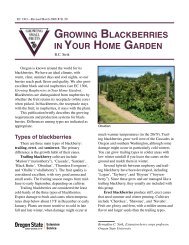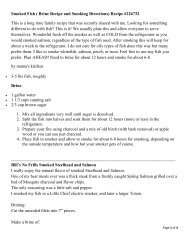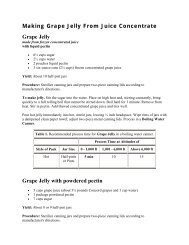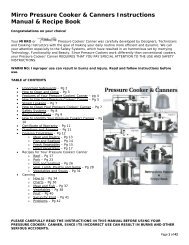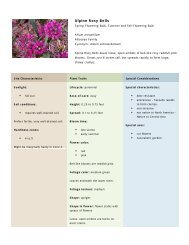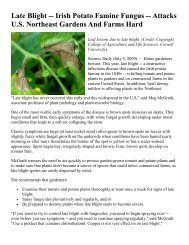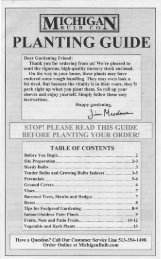Strawberry and Raspberry Pest Management in Wisconsin
Strawberry and Raspberry Pest Management in Wisconsin
Strawberry and Raspberry Pest Management in Wisconsin
Create successful ePaper yourself
Turn your PDF publications into a flip-book with our unique Google optimized e-Paper software.
Table 3. Toxicity categories of pesticides<br />
Toxicity category<br />
I II III IV<br />
High<br />
Moderate<br />
Slight<br />
Low<br />
Measure of toxicity<br />
toxicity<br />
toxicity<br />
toxicity<br />
toxicity<br />
Oral LD50 (mg/kg) 0–50 50–500 500–5,000 >5,000<br />
Dermal LD 50 (mg/kg) 0–200 200–2,000 2,000–20,000 >20,000<br />
Inhalation LC 50<br />
gas/vapor (ppm)<br />
dust/mist (mg/l)<br />
0–200<br />
0–0.2<br />
200–2,000<br />
0.2–2<br />
Eye effects corrosive irritation for<br />
7 days<br />
2,000–20,000<br />
2–20<br />
irritation for<br />
20,000<br />
>20<br />
none<br />
mild<br />
irritation<br />
Signal word DANGER a WARNING CAUTION CAUTION<br />
mg/kg = milligrams per kilogram < = less than<br />
ppm = parts per million > = greater than<br />
mg/l = milligrams per liter<br />
a Products assigned to Category I due to oral, <strong>in</strong>halation, or dermal toxicity (as dist<strong>in</strong>ct from eye <strong>and</strong> sk<strong>in</strong><br />
local effects) also must have the word “poison” <strong>and</strong> the “skull <strong>and</strong> crossbones” symbol on the label.<br />
HUMAN POISONING <strong>Pest</strong>icide poison<strong>in</strong>g. The effects of organophosphate <strong>and</strong> carbamate<br />
poison<strong>in</strong>g are rapid. Poison<strong>in</strong>g must be recognized early for effective<br />
treatment. Early symptoms are usually a headache, feel<strong>in</strong>g of weakness,<br />
blurred vision, excessive perspiration, <strong>and</strong> nausea. Abdom<strong>in</strong>al cramps,<br />
vomit<strong>in</strong>g, <strong>and</strong> excessive salivation may set <strong>in</strong> with, or without, diarrhea.<br />
The throat <strong>and</strong> chest will feel constricted <strong>and</strong> breath<strong>in</strong>g will be difficult.<br />
In mild cases of poison<strong>in</strong>g, some of these symptoms may be absent.<br />
In case of human poison<strong>in</strong>g. Call a doctor at once if you suspect<br />
organophosphate or carbamate poison<strong>in</strong>g. If symptoms develop <strong>and</strong><br />
the patient is conscious, give two atrop<strong>in</strong>e tablets (1/100 gra<strong>in</strong>s each)<br />
immediately. Move the <strong>in</strong>dividual from the area of exposure. Remove<br />
contam<strong>in</strong>ated cloth<strong>in</strong>g <strong>and</strong> wash sk<strong>in</strong> with plenty of soap <strong>and</strong> water to<br />
remove all traces of the chemical. If chemical is swallowed, <strong>in</strong>duce<br />
vomit<strong>in</strong>g by giv<strong>in</strong>g warm soapy water. Avoid all further exposure to<br />
phosphate or carbamate <strong>in</strong>secticides. Victims are very susceptible to<br />
even small exposures until blood <strong>and</strong> tissue chol<strong>in</strong>esterase regenerate.<br />
Atrop<strong>in</strong>e is not an antidote for all pesticides. If there is any doubt, read<br />
the pesticide label before act<strong>in</strong>g. Each pesticide has treatment<br />
<strong>in</strong>formation on the label. Beg<strong>in</strong> this treatment as soon as possible. Take<br />
the victim to professional medical help immediately. Take along a copy<br />
of the pesticide label, or at least the chemical <strong>and</strong> common names of<br />
the active <strong>in</strong>gredient(s) <strong>and</strong> the name <strong>and</strong> address of the manufacturer.<br />
A medical emergency phone number often is listed on the pesticide<br />
label. The product’s Material Safety Data Sheet (MSDS) is a more<br />
technical document than the label, <strong>and</strong> it often conta<strong>in</strong>s additional<br />
treatment <strong>in</strong>structions for the attend<strong>in</strong>g medical professional.<br />
Poison Control Center (1-800-222-1222). You may call the Poison<br />
Control Center at any hour for <strong>in</strong>formation regard<strong>in</strong>g proper treatment<br />
of pesticide poison<strong>in</strong>g. While other hospitals <strong>and</strong> medical facilities may<br />
have some <strong>in</strong>formation, the Poison Control Center has the most<br />
complete <strong>and</strong> current files <strong>and</strong> their personnel are specifically tra<strong>in</strong>ed<br />
to deal with poison cases.<br />
7




